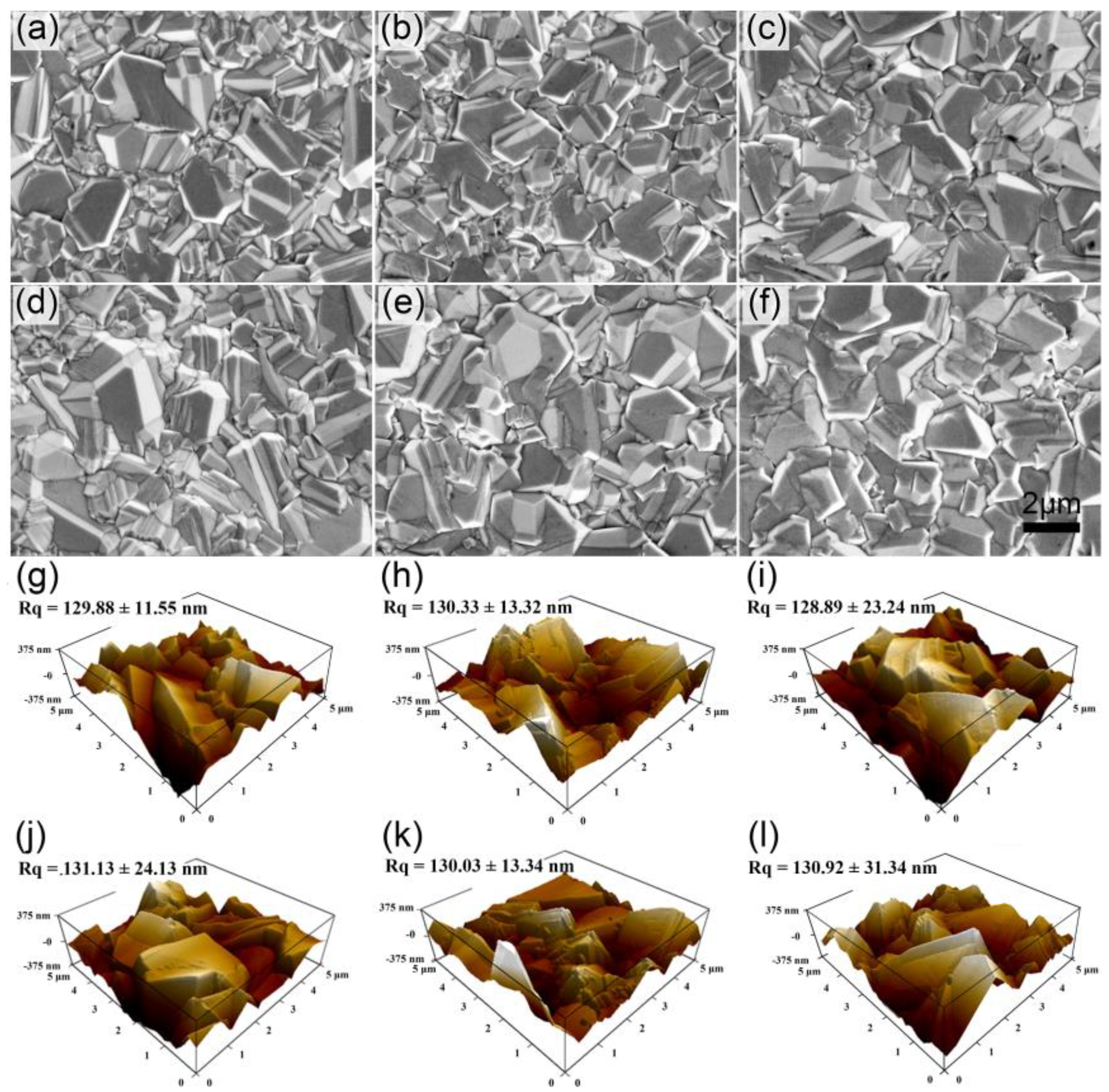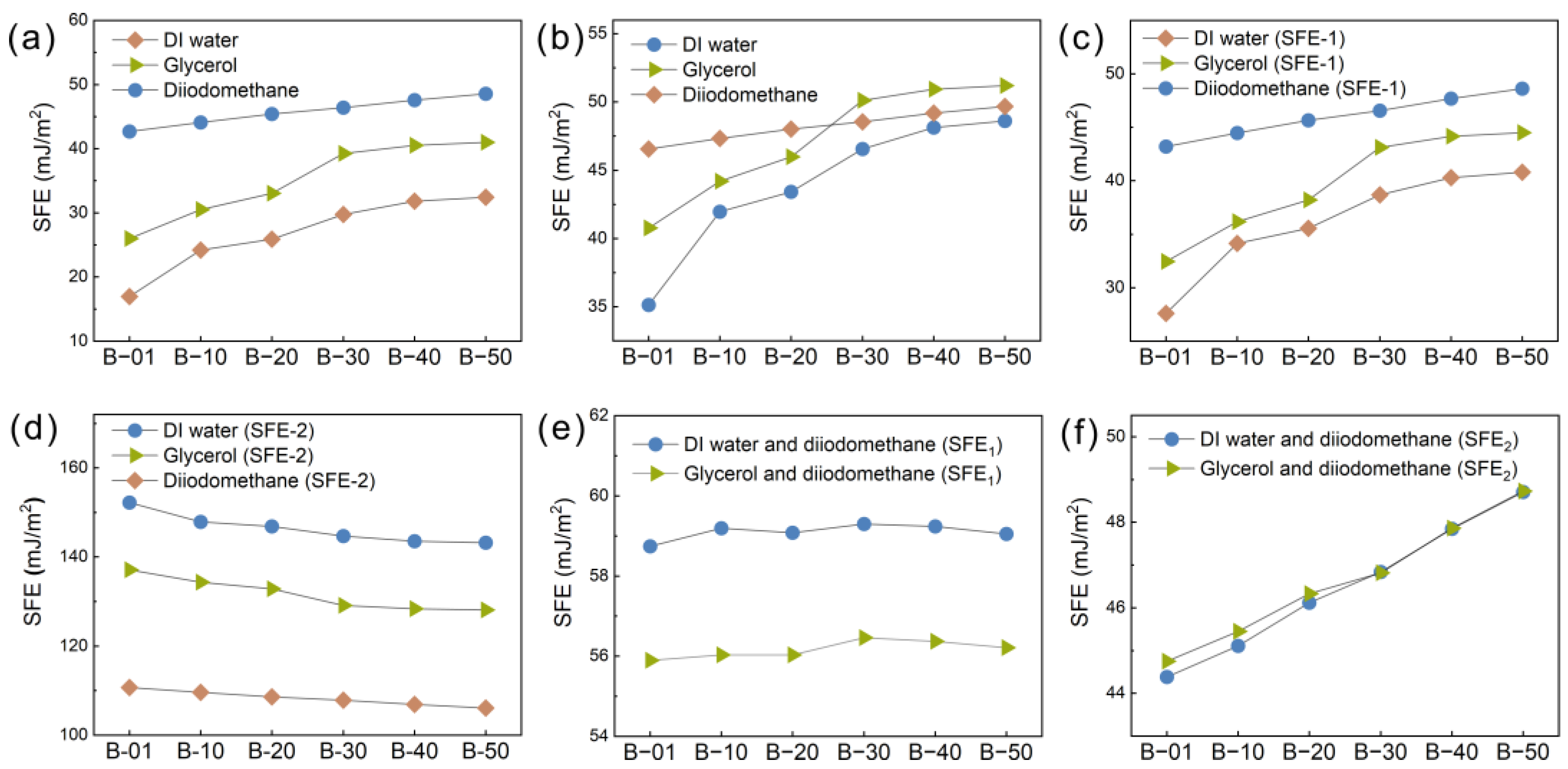Effect of Boron Doping Concentration on the Wettability and Surface Free Energy of Polycrystalline Boron-Doped Diamond Film
Abstract
1. Introduction
2. Materials and Methods
2.1. Silicon Wafer Treatment
2.2. Deposition of PBDD Film on Silicon Wafer
2.3. Characterization
2.4. Contact Angle Measurement
3. Results and Discussion
4. Conclusions
Supplementary Materials
Author Contributions
Funding
Institutional Review Board Statement
Informed Consent Statement
Data Availability Statement
Conflicts of Interest
References
- Annamalai, M.; Gopinadhan, K.; Han, S.A.; Saha, S.; Park, H.J.; Cho, E.B.; Kumar, B.; Patra, A.; Kim, S.-W.; Venkatesan, T. Surface energy and wettability of van der Waals structures. Nanoscale 2016, 8, 5764–5770. [Google Scholar] [CrossRef] [PubMed]
- Jin, H.; Tian, L.; Bing, W.; Zhao, J.; Ren, L. Bioinspired marine antifouling coatings: Status, prospects, and future. Prog. Mater. Sci. 2022, 124, 100889. [Google Scholar]
- Burris, D.L.; Zhao, S.; Duncan, R.; Lowitz, J.; Perry, S.S.; Schadler, L.S.; Sawyer, W.G. A route to wear resistant PTFE via trace loadings of functionalized nanofillers. Wear 2009, 267, 653–660. [Google Scholar] [CrossRef]
- Muzyka, K.; Sun, J.; Fereja, T.H.; Lan, Y.; Zhang, W.; Xu, G. Boron-doped diamond: Current progress and challenges in view of electroanalytical applications. Anal. Methods 2019, 11, 397–414. [Google Scholar] [CrossRef]
- Tyagi, A.; Walia, R.S.; Murtaza, Q.; Pandey, S.M.; Tyagi, P.K.; Bajaj, B. A critical review of diamond like carbon coating for wear resistance applications. Int. J. Refract. Hard Met. 2019, 78, 107–122. [Google Scholar] [CrossRef]
- Zhang, Y.; Zhang, F.; Chen, G. Surface energies and morphologies of chemical-vapor-deposited diamond films. J. Appl. Phys. 1994, 76, 7805–7808. [Google Scholar] [CrossRef]
- Ma, Z.-C.; Gao, N.; Cheng, S.-H.; Liu, J.-S.; Yang, M.-C.; Wang, P.; Feng, Z.-Y.; Wang, Q.-L.; Li, H.-D. Wettability and Surface Energy of Hydrogen- and Oxygen-Terminated Diamond Films. Chin. Phys. Lett. 2020, 37, 046801. [Google Scholar] [CrossRef]
- Tian, S.; Xu, F.; Sun, S.; Zhao, Y.C.; Wang, X.; Zuo, D.W. Growth rate and surface free energy of diamond films using different gas-sources. Surf. Eng. 2020, 36, 379–385. [Google Scholar] [CrossRef]
- Skrobas, K.; Stefanska-Skrobas, K.; Stelmakh, S.; Gierlotka, S.; Palosz, B. Surface free energy of diamond nanocrystals—A molecular dynamics study of its size dependence. Phys. Chem. Chem. Phys. 2021, 23, 11075–11081. [Google Scholar] [CrossRef]
- Zhao, T.; Jiang, L. Contact angle measurement of natural materials. Colloids Surf. B 2018, 161, 324–330. [Google Scholar] [CrossRef]
- Han, B.; Wang, P.; Jin, H.; Hou, Z.; Bai, X. Wettability and surface energy of parylene F deposited on PDMS. Phys. Lett. A 2020, 384, 126628. [Google Scholar] [CrossRef]
- Young, T., III. An essay on the cohesion of fluids. Philos. Trans. R. Soc. Lond. 1805, 95, 65–87. [Google Scholar]
- Kwok, D.Y.; Neumann, A.W. Contact angle measurement and contact angle interpretation. Adv. Colloid Interface Sci. 1999, 81, 167–249. [Google Scholar] [CrossRef]
- Fowkes, F.M. Attractive forces at interfaces. Ind. Eng. Chem. Res. 1964, 56, 40–52. [Google Scholar] [CrossRef]
- Owens, D.K.; Wendt, R.C. Estimation of the surface free energy of polymers. J. Appl. Polym. Sci. 1969, 13, 1741–1747. [Google Scholar] [CrossRef]
- Van Oss, C.J.; Chaudhury, M.K.; Good, R.J. Interfacial Lifshitz-van der Waals and polar interactions in macroscopic systems. Chem. Rev. 1988, 88, 927–941. [Google Scholar] [CrossRef]
- Antonow, G.N. Sur la tension superficielle à la limite de deux couches. J. Chim. Phys. 1907, 5, 372–385. [Google Scholar] [CrossRef]
- Daniel, B. Sur le mélange des gaz. Compt. Rendus 1898, 126, 1703–1706. [Google Scholar]
- Kwok, D.Y.; Neumann, A.W. Contact angle interpretation in terms of solid surface tension. Colloids Surf. A Physicochem. Eng. Asp. 2000, 161, 31–48. [Google Scholar] [CrossRef]
- Sharma, D.K.; Girão, A.V.; Chapon, P.; Neto, M.A.; Oliveira, F.J.; Silva, R.F. Advances in RF glow discharge optical emission spectrometry characterization of intrinsic and boron-doped diamond coatings. ACS Appl. Mater. Interfaces 2022, 14, 7405–7416. [Google Scholar] [CrossRef]
- de Oliveira Silva, K.N.; Rodrigo, M.A.; dos Santos, E.V. Electrochemical treatment of soil-washing effluent with boron-doped diamond electrodes: A review. Curr. Opin. Solid State Mater. Sci. 2021, 25, 100962. [Google Scholar] [CrossRef]
- Lan, Y.; Coetsier, C.; Causserand, C.; Groenen Serrano, K. An experimental and modelling study of the electrochemical oxidation of pharmaceuticals using a boron-doped diamond anode. Chem. Eng. J. 2018, 333, 486–494. [Google Scholar] [CrossRef]
- Li, H.; Zhou, K.; Cao, J.; Wei, Q.; Lin, C.-T.; Pei, S.E.; Ma, L.; Hu, N.; Guo, Y.; Deng, Z.; et al. A novel modification to boron-doped diamond electrode for enhanced, selective detection of dopamine in human serum. Carbon 2021, 171, 16–28. [Google Scholar] [CrossRef]
- Choi, U.; Kwak, T.; Han, S.; Kim, S.-W.; Nam, O. High breakdown voltage of boron-doped diamond metal semiconductor field effect transistor grown on freestanding heteroepitaxial diamond substrate. Diam. Relat. Mater. 2022, 121, 108782. [Google Scholar] [CrossRef]
- Zhu, X.; Aslam, D.M. CVD diamond thin film technology for MEMS packaging. Diam. Relat. Mater. 2006, 15, 254–258. [Google Scholar] [CrossRef]
- Guo, C.; Zheng, J.; Deng, H.; Shi, P.; Zhao, G. Photoelectrocatalytic interface of boron-doped diamond: Modification, functionalization and environmental applications. Carbon 2021, 175, 454–466. [Google Scholar] [CrossRef]
- Wang, J.; He, Z.; Tan, X.; Wang, T.; Liu, L.; He, X.; Liu, X.D.; Zhang, L.; Du, K. High-performance 2.6 V aqueous symmetric supercapacitor based on porous boron-doped diamond via regrowth of diamond nanoparticles. Carbon 2020, 160, 71–79. [Google Scholar] [CrossRef]
- Hu, C.-X.; Xiao, Q.; Ren, Y.-Y.; Zhao, M.; Dun, G.-H.; Wu, H.-R.; Li, X.-Y.; Yang, Q.-Q.; Sun, B.; Peng, Y.; et al. Polymer Ionic Liquid Stabilized Black Phosphorus for Environmental Robust Flexible Optoelectronics. Adv. Funct. Mater. 2018, 28, 1805311. [Google Scholar] [CrossRef]
- Hideo, N.; Ryuichi, I.; Yosuke, H.; Hiroyuki, S. Effects of surface roughness on wettability. Acta Mater. 1998, 46, 2313–2318. [Google Scholar] [CrossRef]
- Yao, K.; Dai, B.; Tan, X.; Yang, L.; Zhao, J.; Ralchenko, V.; Shu, G.; Liu, K.; Han, J.; Zhu, J. Microwave plasma-assisted chemical vapor deposition of microcrystalline diamond films via graphite etching under different hydrogen flow rates. CrystEngComm 2019, 21, 2502–2507. [Google Scholar] [CrossRef]
- Tiwari, R.N.; Chang, L. Growth, microstructure, and field-emission properties of synthesized diamond film on adamantane-coated silicon substrate by microwave plasma chemical vapor deposition. J. Appl. Phys. 2010, 107, 103305. [Google Scholar] [CrossRef]
- Zhang, Z.; Lin, C.; Yang, X.; Tian, Y.; Gao, C.; Li, K.; Zang, J.; Yang, X.; Dong, L.; Shan, C. Solar-blind imaging based on 2-inch polycrystalline diamond photodetector linear array. Carbon 2021, 173, 427–432. [Google Scholar] [CrossRef]
- Mortet, V.; Živcová, Z.V.; Taylor, A.; Davydová, M.; Frank, O.; Hubík, P.; Lorincik, J.; Aleshin, M. Determination of atomic boron concentration in heavily boron-doped diamond by Raman spectroscopy. Diam. Relat. Mater. 2019, 93, 54–58. [Google Scholar] [CrossRef]
- Ndao, A.N.; Zenia, F.; Deneuville, A.; Bernard, M.; Lévy-Clément, C. Effect of boron concentration on the electrochemical reduction of nitrates on polycrystalline diamond electrodes. Diam. Relat. Mater. 2000, 9, 1175–1180. [Google Scholar] [CrossRef]
- Lévy-Clément, C.; Ndao, N.A.; Katty, A.; Bernard, M.; Deneuville, A.; Comninellis, C.; Fujishima, A. Boron doped diamond electrodes for nitrate elimination in concentrated wastewater. Diam. Relat. Mater. 2003, 12, 606–612. [Google Scholar] [CrossRef]
- Girolami, M.; Bellucci, A.; Mastellone, M.; Orlando, S.; Serpente, V.; Valentini, V.; Polini, R.; Sani, E.; De Caro, T.; Trucchi, D.M. femtosecond-laser nanostructuring of black diamond films under different gas environments. Materials 2020, 13, 5761. [Google Scholar] [CrossRef]
- Gu, Y. Drop size dependence of contact angles of oil drops on a solid surface in water. Colloids Surf. A Physicochem. Eng. Asp. 2001, 181, 215–224. [Google Scholar] [CrossRef]
- Ho, C.C.; Khew, M.C. Surface free energy analysis of natural and modified natural rubber latex films by contact angle method. Langmuir 2000, 16, 1407–1414. [Google Scholar] [CrossRef]





| Combinations | Modifying Factor | Mean (m2/mJ) | Standard Deviation (m2/mJ) |
|---|---|---|---|
| DI water-diiodomethane | β1 | 1.75 × 10−3 | ±0.0003603 |
| β2 | 3.48 × 10−4 | ±0.0000656 | |
| Glycerol-diiodomethane | β1 | 3.43 × 10−3 | ±0.0009535 |
| β2 | 4.36 × 10−4 | ±0.0001419 |
| PBDD Films | DI Water and Diiodomethane SFE2 (m2/mJ) | Glycerol and Diiodomethane SFE2 (m2/mJ) |
|---|---|---|
| B−01 | 44.38 | 44.75 |
| B−10 | 45.11 | 45.45 |
| B−20 | 46.12 | 46.33 |
| B−30 | 46.84 | 46.82 |
| B−40 | 47.85 | 47.86 |
| B−50 | 48.71 | 48.73 |
Disclaimer/Publisher’s Note: The statements, opinions and data contained in all publications are solely those of the individual author(s) and contributor(s) and not of MDPI and/or the editor(s). MDPI and/or the editor(s) disclaim responsibility for any injury to people or property resulting from any ideas, methods, instructions or products referred to in the content. |
© 2023 by the authors. Licensee MDPI, Basel, Switzerland. This article is an open access article distributed under the terms and conditions of the Creative Commons Attribution (CC BY) license (https://creativecommons.org/licenses/by/4.0/).
Share and Cite
Wang, P.; Yu, Q.; Yuan, X.; Cui, Z.; Liu, Y.; Gao, N.; Jin, H.; Cheng, S.; Liu, J.; Li, H. Effect of Boron Doping Concentration on the Wettability and Surface Free Energy of Polycrystalline Boron-Doped Diamond Film. Coatings 2023, 13, 305. https://doi.org/10.3390/coatings13020305
Wang P, Yu Q, Yuan X, Cui Z, Liu Y, Gao N, Jin H, Cheng S, Liu J, Li H. Effect of Boron Doping Concentration on the Wettability and Surface Free Energy of Polycrystalline Boron-Doped Diamond Film. Coatings. 2023; 13(2):305. https://doi.org/10.3390/coatings13020305
Chicago/Turabian StyleWang, Peng, Qiyuan Yu, Xiaoxi Yuan, Zheng Cui, Yaofeng Liu, Nan Gao, Huichao Jin, Shaoheng Cheng, Junsong Liu, and Hongdong Li. 2023. "Effect of Boron Doping Concentration on the Wettability and Surface Free Energy of Polycrystalline Boron-Doped Diamond Film" Coatings 13, no. 2: 305. https://doi.org/10.3390/coatings13020305
APA StyleWang, P., Yu, Q., Yuan, X., Cui, Z., Liu, Y., Gao, N., Jin, H., Cheng, S., Liu, J., & Li, H. (2023). Effect of Boron Doping Concentration on the Wettability and Surface Free Energy of Polycrystalline Boron-Doped Diamond Film. Coatings, 13(2), 305. https://doi.org/10.3390/coatings13020305










